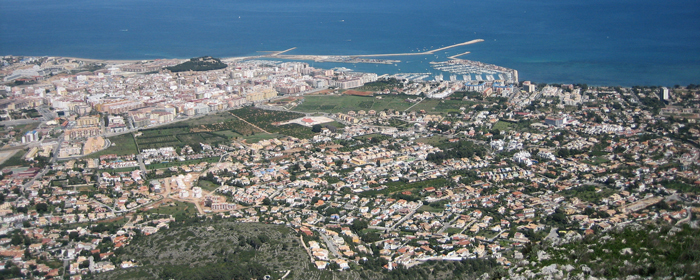Dénia - A Muslim Port in Spain
Dénia is a historical coastal city in the province of Alicante, Spain, on the Costa Blanca halfway between Alicante and Valencia, and the capital and judicial seat of the comarca of Marina Alta. Dénia's historical heritage has been influenced by Iberian, Greek, Roman, Islamic, Napoleonic and Christian civilizations.

History
There is evidence of human habitation in the area since prehistoric times and there are significant Iberian ruins on the hillsides nearby. In the 4th century BC it was a Greek colony of Marseille or Empúries, perhaps the one mentioned by Strabo as Hēmeroskopeion (meaning "watchtower"). It was an ally of Rome during the Punic Wars, and later was absorbed into the Roman Empire under the name of Dianium (after their goddess Diana). In the 1st century BC Quintus Sertorius established a Roman naval base here.
In 636-696 AD, during the Visigothic Kingdom of Iberia, it was the seat of a bishop from Toledo. After the Muslim conquest of Iberia and the dissolution of the Caliphate of Córdoba, Dénia (known as Dāniyah or دانية in Arabic which means lowland) became the capital of a taifa kingdom that reigned over part of the Valencian coast and Ibiza. The Slavic Muslim slaves, saqālibah, led by Mujahid ibn Yusuf ibn Ali their leader, who could take profit from the progressive crumbling of the Caliphate's superstructure to gain control over the province of Dénia. The Saqaliba managed to free themselves and run the Taifa of Dénia which extended its reach as far as the islands of Majorca and its capital Madinah Mayurqah. The Saqaliba Taifa lost its independence in 1076, when it was captured by Ahmad al-Muqtadir, lord of Zaragoza, under which it remained until the Almoravid invasion in 1091. The Muslim Arabs originally built the castle fortress, and the French, who occupied the city for four years during the Peninsular War, re-built it in the early 19th century.
The town was reconquered by the Christians in 1244. This caused a decline for the city, which remained nearly uninhabited after the exile of most of the Muslim population. It was later repopulated by the Valencian government. Created a fief in 1298, it was held by the de Sandoval family from 1431, although the city itself was returned to Aragonese crown in 1455. A marquisate from 1487, Dénia gained many privileges thanks to Francisco Gómez de Sandoval y Rojas, Duke of Lerma, a favourite of Philip III of Spain. It suffered a further period of decay after the decree of Expulsion of the Moriscos (1609), by which 25,000 people left the marquisate, leaving the local economy in a dismal state.
During the War of the Spanish Succession Dénia was besieged by 9,000 French troops in June 1707, who broke down several sections of the town walls using cannon, but their attacks in July were repulsed by the small garrison with great loss of life to the attackers resulting in the siege being raised after 27 days. Dénia, however, fell to the French forces that November. In 1713 the Treaty of Utrecht recognised Louis XIV's grandson Philip, Duke of Anjou, as King of Spain (as Philip V), so returning Dénia to Spanish rule.
It was reacquired by the Spanish crown in 1803, after which Denia gained an increasingly important role as a trading port. A community of English raisin traders lived in Dénia from 1800 until the time of the Spanish Civil War in the late 1930s.
Time TeamDig DéniaTony Robinson and the experts turn their backs on Benidorm to travel a few miles up the coast to the small port of Dénia to show what life was like 1000 years ago, when Dénia was an Islamic settlement. |
|

